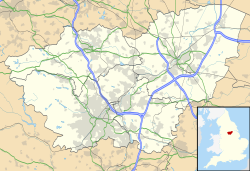History
In 1915, land on the south-eastern edge of Sheffield, was prepared to become a landing ground for the use of No.33 Sqn in the Home Defence role across Northern England. [1] The base was named Coal Aston and was to the west of RAF Norton by some 1.452 miles (2.337 km). [2] [3] An altar made from the propellers of crashed aircraft on the Western Front was made here by RAF apprentices in 1919. It was installed in the Airmens Chapel at Southwell Minster. [4] [note 2] This location closed in 1919. [7]
With the threat of another war, steps were taken for the defence of important industrial areas of Britain. [8] Sheffield was designated as No. 16 Balloon Centre with No. 33 Group, part of Balloon Command, and the 155-acre (63 ha) RAF Lightwood site was opened in 1939 off Lightwood Lane in Norton to provide a base for training and deployment of a balloon barrage around Sheffield. [9] [10] [11] The site had two squadrons, No. 939 and No 940 Squadrons who had 40 balloons (in five flights) and 32 balloons (in four flights) respectively. No 939 Sqn had a responsibility for Sheffield, and No. 940 had the responsibility for Rotherham. [12] [13] The balloon squadrons soon were converted to being operated by the WAAF so that the men of the RAF could be released for active duty elsewhere. However, the women of the WAAF at Norton were billeted to two per bed, something which the director of the WAAF complained "bitterly" about in April 1940. [14]
After the threat of Luftwaffe action had receded in 1943, the balloons were moved south to defend London and the squadrons at Lightwood disbanded. The base was renamed RAF Norton, and handed over from Balloon Command to Signals Command, with No. 3 Ground Radio and Radar Servicing Squadron (3GRRSS) taking over. [15] 3GRSS used RAF Norton until its closure in 1965. [16] Unlike nearby RAF Coal Aston, RAF Lightwood/RAF Norton was never furnished with a runway or active airfield. [17]
Between 1943 and 1945, Norton was also the site of an aircrew refresher school, a place where those who were branded as having a "Lack of Moral Fibre" (LMF) within Bomber Command were sent to be "corrected". [18] Sometimes, those who endured the three-week course at Norton were sent there simply because their commanding officer believed they had lost their nerve. [19]
The role of the base post Second World War was to train and support the RAF Signals cadre; in 1956, No. 90 Signals Group sent a convoy from Norton to Famagusta in Cyprus. [20] Between 1955 and 1961, Supermarine Spitfire F24 (no. PK724) was used for instructional purposes at Norton, having been sent from No. 9 Maintenance Unit at Cosford. [21] Another Spitfire (TB308) was also based at Norton in the late 1950s, like PK724, it was used as an instructional aircraft. [22] TB308 was scrapped at RAF Bicester in the early 1960s, but PK724 was preserved in the national collection at the museum in Hendon. [21] [23] During the 1950s, the base held many air shows, but aircraft flew in from other bases as the site was not equipped with a runway (despite sometimes being referred to as an aerodrome). [15] [17]
The site was used to accommodate rescue and relief workers in February 1962 after storm-force gales had hit the Sheffield area killing four, wounding 250 and damaging 70,000 homes. [24] The ensign at RAF Norton was lowered for the last time on 29 January 1965, with complete closure happening in the same year. [10]
This page is based on this
Wikipedia article Text is available under the
CC BY-SA 4.0 license; additional terms may apply.
Images, videos and audio are available under their respective licenses.

